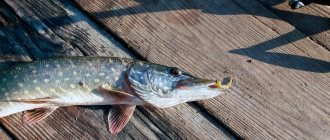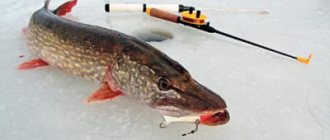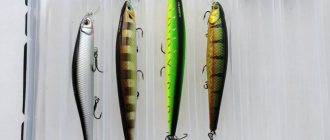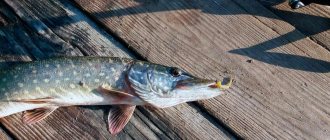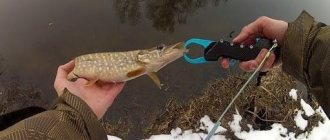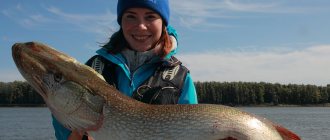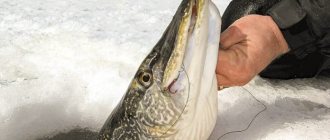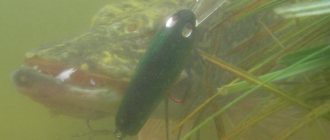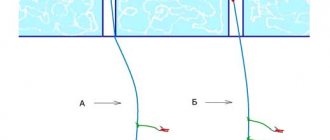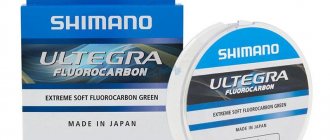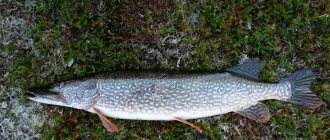When using a single hook or tee, fish often disappear at the most crucial moment. The hook falls out of the mouth or the pike spits it out, I feel discomfort in the mouth. But if the pike still swallows the tee, then the fisherman pulls it out with virtually no resistance.
Float for pike
Equipment for catching pike with live bait. In the first case, the fishing line is tangled, in the second we show how to avoid this
At the moment of casting, such a float is located next to the load, which then, falling deeper, pulls the fishing line along with it until a stopper attached to the fishing line at the appropriate height stops the float in the set position. 3-4 small floats (pilots) can be placed on the fishing line above the float to hold the fishing line on the surface of the water, as well as to indicate the direction of movement of the fish that floods the main float at the time of the bite.
An annoying drawback of this method is the frequent tangling of the fishing line with live bait, float and weight. Casting must be thoroughly mastered and your hand trained, so to speak.
Two ways of mounting on a pike
Catching pike with live bait on a float from a boat has a number of features compared to fishing from the shore. When using a boat, the fishing zone increases significantly; the boat allows you to fish in places inaccessible from the shore. When fishing from a boat, it is more convenient to use a shorter rod, 2.5-3 meters, since a longer one is inconvenient for catching a pecked predator. You need to anchor carefully, at some distance from the fishing point; you can use snags sticking out of the water to tie the boat to them.
Catching pike with live bait on a float is an interesting and dynamic type of predator fishing; anglers have been catching pike this way for a long time. The best results are achieved by fishing in late summer and autumn, when pike fatten up before wintering. You can fish this way until the freeze-up.
Optimal fishing spot.
Typically, pike are caught with live bait on small and medium-sized rivers, lakes, ponds and dams. The depth at the fishing site is rarely more than three meters, and coastal areas of reservoirs covered with aquatic vegetation are the best place for catching pike with live bait on a float. If there are snags in the fishing zone, the likelihood of a toothy bite increases significantly, since the pike usually lies in ambush among snags or algae.
Tackle for pike fishing.
After a bite, the pike usually tends to hide in a thicket of algae or in snags, so it is necessary to use a powerful rod, 4-6 meters long, which will allow you to cast heavy equipment and forcefully fish out the predator that has bitten, preventing the fish from going into the snags.
A float with a carrying capacity of 30-40 grams, an olive sinker and the obligatory steel or titanium leash 25-40 cm long - this is the equipment of a fishing rod for catching pike with live bait on a float. The fishing line is used with a diameter of 0.3-0.35 mm; a thinner line may not withstand landing large fish, and a thicker line will not allow you to cast the tackle normally.
The best bait is live bait.
Tactics for catching pike with a float rod.
Catching pike with live bait on a float from a boat.
Catching pike with live bait on a float from a boat has a number of features compared to fishing from the shore. When using a boat, the fishing zone increases significantly; the boat allows you to fish in places inaccessible from the shore. When fishing from a boat, it is more convenient to use a shorter rod, 2.5-3 meters, since a longer one is inconvenient for catching a pecked predator. You need to anchor carefully, at some distance from the fishing point; you can use snags sticking out of the water to tie the boat to them.
Tips for fisherman: Real fishing, how to catch a damn pike - What is the difference, pros and cons
In conclusion, I would like to note that catching pike with live bait on a float is an interesting, dynamic and prey method that allows you to have a catch even when the predator does not bite on artificial baits.
Crucian carp has the longest shelf life. However, it quickly loses its vitality after it is hooked, and in this it is inferior to perches and minnows. This means that the consumption of live bait will be quite large.
Fishing on the current
To catch pike in the river, you need to make vertical casts. The main feature of the method is the slow demonstration of the bait near the bottom. If a light bait is used, then it is lowered by drifting to about half the depth. If there is an underwater obstacle, you need to check the space near the bait every half hour, as fish may be hiding there. After hooking the prey, it must be quickly caught from the main current.
Fishing in still water
Unlike the river variety, which is almost problem-free to catch, fishing in still water requires compliance with certain conditions.
Before you go fishing for pike, you should carefully study the features of the chosen reservoir.:
- flow;
- closed borders;
- flow.
In closed reservoirs, it is better to look for fish in areas where the vegetation is very abundant. It is worth considering that in still water the fish generally move little.
With the arrival of cold weather, pike can usually be found:
- in pits;
- on the shallows;
- in sharp transitions of depth;
- in snarled areas.
The most versatile and effective way of fishing is to catch pike with a fishing rod and float. The design of a float rod for catching a predator is no different from a float for crucian carp. Only all the elements in it are more durable and rough. And instead of a thin fishing line, the leash is made of wire or cable.
The most versatile and effective way of fishing is to catch pike with a fishing rod and float. The design of a float rod for catching a predator is no different from a float for crucian carp. Only all the elements in it are more durable and rough. And instead of a thin fishing line, the leash is made of wire or cable.
Since catching pike with a float rod with live bait requires the angler to actively move around the reservoir, it is recommended to use telescopic rods to save time (their use will save a lot of time on disassembling and assembling gear). It is best to use fishing rods with a length of no more than five meters and with a dough of no more than 30 grams.
The choice of reel model depends only on the preferences of the angler. To catch pike with a fishing rod in overgrown places, it is best to use inertial reels; they will allow you to pull the fish out, even from blind hooks. The use of spinning reels makes it possible to deliver equipment over long distances without harming live bait.
It is best to choose a line with an excess breaking load. If it’s not there, then the trick with the clutch, like on a spinning rod, won’t work, the tackle is very long and the pike will simply confuse it. When catching pike on a float, it becomes necessary to roughly fish out the fish, the so-called “impudence” among fishermen. And the fisherman must be sure that the fishing line will withstand a heavy load. Mono line is used up to 0.4 mm in diameter, and braided up to 0.2.
Tips for a fisherman: How to tie a lure to a winter fishing rod - Tips for a beginner
In a fishing rod for catching pike with live bait, it is necessary to use floats capable of lifting a heavy load. The main thing is to choose floats of such a size that the bait fish cannot drag it under water, and the pike does not notice its resistance when biting.
Hooks can be used as double or tee hooks. Number 10 is best.
The equipment of a fishing rod can be anything - a blind one, without a reel, or a running one, equipped with a reel. The design of the fishing rod must take into account that the pike is not a small and very strong fish, which fights for its life to the last and offers powerful resistance when fishing, and even with a large number of extremely sharp teeth, which can easily bite through something that is not strong enough for once or twice. fishing line
Choosing the optimal fishing line diameter
With fishing line, everything is not so simple, and you have to look for certain compromises. If in a spinning rod a thick monofilament line or braid can only worsen the performance of the bait and reduce control over the retrieve, then in live bait fishing everything is different - the pike has the opportunity to adjust to the attack for a long time, being very close to the equipment, not to rush to bite, observing the behavior of the live bait. Therefore, the most important thing is a 0.25 mm fishing line, either on a float bait or on a winter bait - a bet. And only when fishing near “strong” places, near the same thick snags, will I switch to 0.3 mm. Or when the bite of a large pike is real, but on small rivers there is usually a toothy one up to one and a half kilograms, much less often - two or three, and there is plenty of 0.25 mm fishing line. And when I go specifically for perch with fry, I set it to 0.20 mm, although I have long known that pike are often caught on a perch fishing rod, even during periods of extremely weak feeding activity. Of course, I don’t reach a significant part of the pike with the perch rig – it lacks strength, but the very fact of many bites is interesting. I won’t speculate about the reasons for the effectiveness of thin lines when catching sluggish pikes, I’m just stating a fact.
Rod selection
It is better to choose a rod with a length of four to five meters; anything longer will be inconvenient. The fishing line is monofilament, having a thickness from twenty-two hundredths of a millimeter to twenty-eight hundredths of a millimeter. The optimal thickness will be twenty-six hundredths of a millimeter, and the maximum thickness will be thirty-five hundredths of a millimeter. It’s also a good idea to pay attention to the quality of the fishing line itself; if it’s good, you can use a fishing line one and a half millimeters thick to pull out a kilogram specimen without any problems.
Mastering the technique of catching pike with a float will not cause any particular difficulties for anyone who already has at least initial fishing experience. But it can take a long time to become truly successful at it.
Choice of live bait
Any small fish as bait for catching pike on a float . It is better to choose from those that are found in the reservoir in which fishing will take place. Live bait, which is a common most attractive to it It could be :
- crucian carp;
- roach;
- rudd;
- bleak;
- gudgeon;
- perch and other fish.
catch live bait using a bait net or a float rod. In the event that you need bait for hunting pike, the second option is more preferable, since the small fish that are usually caught in the bait are too small. By feeding a point not far from the shore, you can catch 20-50 live bait with a float rod in half an hour or an hour, which is enough for pike fishing.
To carry bait you need a special container - a canna. It should hold the required amount of live bait and at the same time be light enough to walk along the shore with it all day. The best option is a container measuring 6-8 liters.
There are two ways to attach live bait for pike fishing to a float.
When hooking a fish through the gills or through the nostril, it is minimally injured. Thanks to this, live bait remains alive for a long time, and their consumption is minimal.
«>
Bait selection
The bait is live bait . It can be a small, about ten centimeters, perch, rattan, roach, minnow, bleak or other fish of this size - just right for a pike weighing up to two kilograms. If you take live bait a little smaller, about five centimeters, then most likely a perch will bite on it. It is better, of course, to catch local live bait, but you can also bring ready-made bait with you, the main thing is that the live bait is alive and mobile. Most often, live bait is attached to the back, the main thing is not to damage the spine. If this happens, the baitfish will be inactive and quickly fall asleep. You need to cast live bait smoothly and carefully, and remove it carefully and smoothly.
When fishing for pike, you need to fish all promising places in the reservoir without exception, waiting for a bite in one place for no more than half an hour (this is the maximum, optimally - about fifteen minutes), if you don’t bite, move to the next place. If the baitfish does fall asleep, you can play with it by pulling it up and down. The number of bites is an unstable concept, for example, during the feeding period it will be ten minutes, and during its passivity it will be fifty minutes, nothing can be done about it.
Hooking when fishing with live bait also has its own characteristics - do not hook after the first bite, but let the pike swallow the bait, lowering the line and waiting (sometimes a minute, sometimes two) and only then, after the second powerful jerk, hook. If you hurry, you can snatch the live bait from the mouth without it being attached and really regret it. However, after hooking, the pike needs to be fished out as quickly as possible so that it does not bite through the monofilament leash or get tangled in snags or thickets.
As practice shows, it is very possible to catch a pike with a regular float rod, but, of course, it will not be a trophy specimen. The maximum that a simple fishing rod can withstand is a pike no more than three kilograms, but after all, a trophy is only meant to be caught occasionally.
Classic fishing
You shouldn’t put too much faith in the words of some sellers of modern fishing rods that the time of the classic fly rod has long passed, because to this day, fishing with this type of rod can bring the fisherman an excellent catch, especially when it comes to fishing with a float rod in the spring, when most fish After the ice melts, a hungry period begins, rich in bites for fishermen.
Modern fly rods that have served for decades are distinguished by the following three parameters:
- Build
- Length
- Material of manufacture
«>
«>
«>
«>
«>
«>
«>
«>
«>
The tackle is equipped with a float of approximately 6 grams and a sinker, which is 2 grams lighter than the float.
Tackle for catching pike with a float rod
It’s not difficult to prepare gear for catching pike in the spring using a float rod; you just need to buy about a five-meter rod that is equipped with rings and a reel seat.
Tips for a fisherman: How to put girders on pike in winter - Let's take it step by step
The fishing line for spring pike fishing should be 0.30 in diameter, as the pike can be caught large.
The tackle is equipped with a float of approximately 6 grams and a sinker, which is 2 grams lighter than the float.
Hooks for catching pike should be No. 12-14; you should not install larger hooks on the fishing rod, since pike are thin by nature, and when they feel metal in their mouth, they will spit it out and you will be left without fish. But with a small hook and a fry attached to it, the pike will take confidently and with the right pause and hook, the pike will not go anywhere.
Do not forget that with a small hook and fighting a pike, the hook can straighten and your prey will swim away.
These fish are not only quite tenacious, but also fit perfectly into the diet of pike, so they will definitely attract its attention.
Gear assembly
How to assemble a tackle or working rod for pike fishing? Experts warn that the equipment must be sliding. This choice is due to the fact that when biting the fish will feel virtually no resistance, and, in addition, with such rods it is easier to cast over long distances.
How to make the perfect tackle for fishing for river predators with your own hands?
It is necessary to adhere to the following algorithm of actions:
- The first step is to tie a slip knot on the main line.
- Next, a small bead or beads are put on, which will prevent the locking knot from slipping into the float loop.
- A sliding float is attached to the fishing line.
- We install a stopper that protects the float from damage by the weight.
- Next, the weight itself is fixed and locked.
- A leash with a hook is attached to the fishing line.
After this, the fishing line will begin to act, and when the fish swallows the bait and moves on, the float will go under the water, at this moment you need to hook.
Unfortunately, there are fewer and fewer fans of this ancient and still reliable method of fishing. This, however, is now progressing in everything. People also prefer surrogates to natural products. Of course, it's not their fault. When it comes to fishing, artificial baits are popular not because they are more tempting to pike. The fact is that it is easier for fishermen, there is less hassle.
What to catch
Rod
First of all, you need to decide on the type of fishing rod. Since pike hunting is carried out by walking with large movements along the shore of the reservoir, the tackle is needed to be mobile, allowing you to quickly fold and unfold. And in terms of speed of bringing into the firing position, not a single fishing rod can compete with a telescope.
The length of the rod should not be particularly long, because a long-distance cast will be ensured by an inertia-free reel. For coastal fishing, a four-meter form will be sufficient and convenient, and for hunting predators from a boat, it is enough to have a three-meter stick.
If fishing is carried out at increased distances, you can use a longer five-meter rod.
For confident hooking, the rigidity of the rod should be above average, and when fishing, a monofilament tensile fishing line will help dampen the jerks of the caught pike.
Coil
The main requirement for a reel that is equipped with a live bait fishing rod is reliability when fishing. After all, the weight of the caught predator and its active resistance greatly load the entire tackle, including the “meat grinder”. A spool size of 3000 Shimano units is quite enough to hold one hundred meters (this is the standard unwinding of fishing line) of working cord.
And, of course, the reel must perfectly balance the rod, which when fishing for pike you often have to hold in your hands for a long time.
fishing line
There is no doubt that monofilament fishing line is most suitable for catching pike with live bait. After all, the tackle does not require special sensitivity, and the bite is clearly visible on the float. The hook is done sweepingly and confidently, and the toothy predator is perfectly pinpointed.
You shouldn’t go too small with the diameter of the fishing line either; a thickness of 0.28-0.35 millimeters is quite suitable for catching pike in any body of water.
Leashes
Here the choice of material for manufacturing is very wide. Depending on the conditions and preferences of the fisherman, they are made from the following materials:
- Monofilament line. Double or triple monofilament woven into a braid is inconspicuous compared to other materials and is quite reliable.
- Fluorocarbon. Despite its thickness, it is often cut by pike teeth, but is least noticeable to the eyes of a predator.
- Steel. The most reliable, but also the most visible and rigid material of all.
- Leading material. Made from many woven steel strands. The advantage is the softness and ease of making the leash.
- Kevlar. Modern soft material, but also tough for pike.
- Titanium-nickel alloy. Ideal in both softness and reliability. It's still rare on the shelves and a bit expensive.
Hooks
Basically, tees are used to equip fishing rods for live bait fishing. Doubles are used to mount particularly tender fry through the mouth. Single rods are practically not used in float live bait gear.
When fishing with tees, live bait clings mainly to the back at the end of the upper fin. The double is used in equipment in this way:
- The lower loop of the leash is threaded through the fry's mouth from the heat side.
- A double hook is threaded through the loop.
- The leash is carefully pulled towards the fry so that the hook points are located on the sides of its mouth.
This type of equipment allows you to fish longer with delicate live bait such as chub, dace or bleak.
Float
Separately, you need to talk about choosing a float for catching pike with live bait. This element of the equipment must necessarily be sliding, this is due to the construction of the entire equipment.
Sliding floats can be of three types:
- with a longitudinal hole in the body;
- with rings in the middle and at the bottom of the body;
- with a single ring at the bottom of the body.
Regardless of the choice of design, the float must slide easily along the line and have a load capacity sufficient to hold the existing bait. Typically, weights from 6 grams to 20 are used. Moreover, part of the load capacity will be accounted for by a sliding load - an olive.
A float suitable for live bait fishing can easily be made with your own hands from a wine cork and a plastic tube. It is enough to drill a through vertical hole in the body and glue a suitable tube into it.
Sinker
In a sliding rod for catching pike with live bait, an olive is used, the weight of which is about a third of the carrying capacity of the float. For example, when using a six-gram rig, the weight of the sinker should be four grams.
If you do not find olives of a suitable weight, supplement the existing one with several spaced pellets until you reach 2/3 of the load.
Installation of gear
For fishing with live bait, sliding equipment is used. This is due to two factors:
- Often fishing takes place in a deep place, casting into which with a blind tackle is impossible or unattainable;
- when biting, the pike will feel less resistance from the gear.
Equipment for catching pike with live bait can be easily made in the following sequence:
- We tie a slip knot on the main line.
- We put on a bead that will prevent the stopper from slipping into the loop of the float.
- We attach the sliding float.
- We install a lower stopper, which during fishing will protect the float from hitting the sinker.
- We mount the olive sinker.
- We stop the olive with a lead pellet or a soft plastic stopper.
- We tie the leash.
- We install the hook.
With this equipment, the fishing rod works as follows:
- The pike takes the bait and moves away with it.
- The sinker and float slide along the line and at the initial stage of the bite do not create additional resistance.
- Then the fishing line begins to work, which lies freely in the water without tension.
- After the predator unfolds the bait, begins to swallow it and moves on, and the float plunges under the water, and you need to make a sweeping hook.
